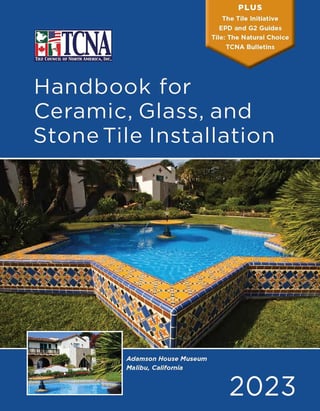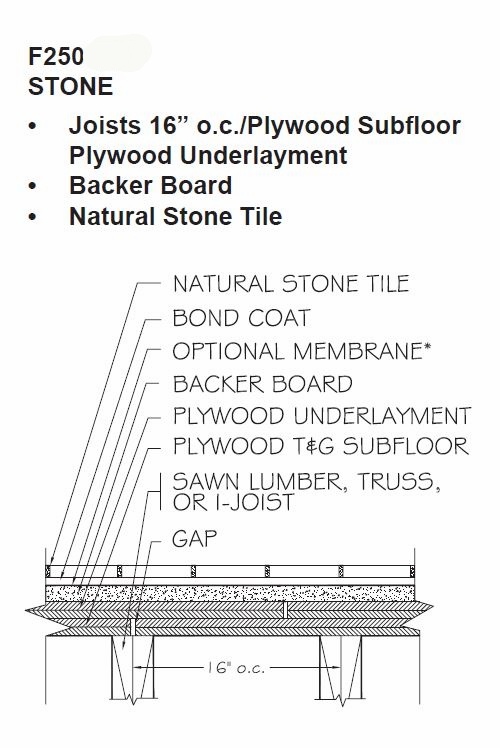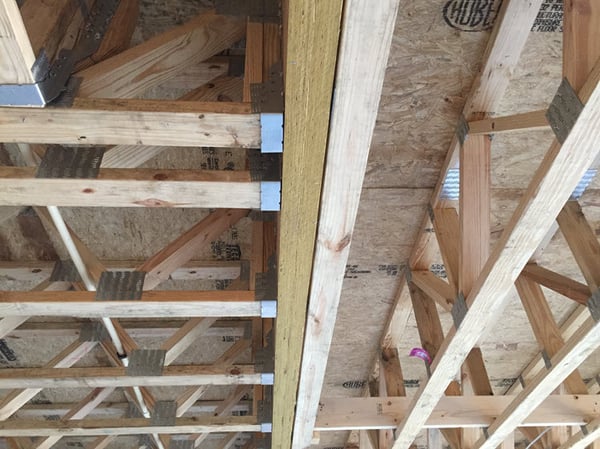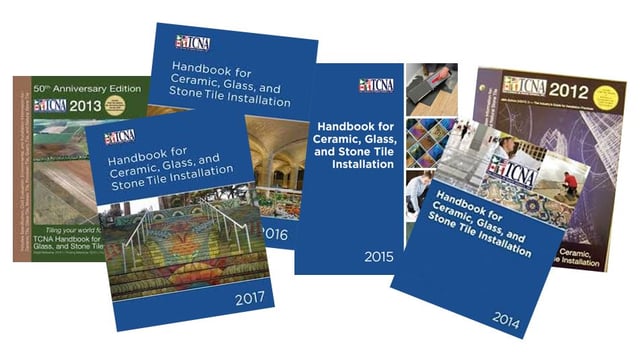 If you spend time with anyone involved in the proper installation of ceramic tile, the TCNA Handbook for Ceramic, Glass, and Stone Tile Installation will be the focal point of the conversation. Why? Because this useful guide assists in clarifying and standardizing installation specifications for tile.
If you spend time with anyone involved in the proper installation of ceramic tile, the TCNA Handbook for Ceramic, Glass, and Stone Tile Installation will be the focal point of the conversation. Why? Because this useful guide assists in clarifying and standardizing installation specifications for tile.
In addition to providing a selection of numbered installation "methods" for differentiating and easy reference, the Handbook includes various product selection guides for ceramic, glass, and stone tiles; guidelines for wet areas; field and installation requirements, and more.
Produced by the Tile Council of North America (TCNA), the TCNA Handbook for Ceramic, Glass, and Stone Tile Installation has been published on a continuous basis since 1963.
Table of Contents
Here's an overview of what you'll find in this article:
What is the TCNA Handbook for Ceramic, Glass, and Stone Tile Installation
Distinct Methods Depending on the Installation Specifics
Guidelines and Best Practices to Help and Protect the Tile Installer
The TCNA Handbook + ANSI Specifications = Perfect Together!
How is the Handbook organized?
The Evolution of the TCNA Handbook
What Makes the Handbook Unique?
Would You Like to Become Involved in the TCNA Handbook?
How the TCNA Handbook Supports Quality Tile Installations
First, What is the TCNA?

Tile Council of North America is a trade association representing manufacturers of ceramic tile, tile installation materials, tile equipment, raw materials, and other tile-related products. It was established in 1945 as the Tile Council of America (TCA). In 2003, it became TCNA reflecting how its membership has expanded to include all of North America.
Tile Council is recognized for its leadership role in facilitating the development of North American and international industry quality standards to benefit tile consumers.
Additionally, TCNA regularly conducts independent research and product testing, works with regulatory, trade, and other government agencies, offers professional training, and publishes industry-consensus guidelines and standards, economic reports, and promotional literature.
One of the highlights of the yearly Coverings show is hearing TCNA Executive Director Eric Astrachan review the state of the ceramic tile industry - from an economic perspective as well as from a creative and trend perspective in North America.
TCNA also strongly supports the mission of the Ceramic Tile Education Foundation.
What is the TCNA Handbook for Ceramic, Glass, and Stone Tile Installation?
The TCNA website describes the Handbook as follows:
"A guide to assist in clarifying and standardizing installation specifications for tile. Each installation recommendation, or method, requires a properly designed, constructed, and prepared substructure using materials and construction techniques that meet nationally recognized material and construction standards. Included are: product selection guides for ceramic, glass, and stone tiles; guidelines for wet areas; ISO mortar and grout specifications; information on substrate flatness requirements; information on grout joint sizes and patterns, and workmanship standards excerpted from ANSI installation standards."
The TCNA Handbook provides installation methods from which to choose, based on the requirements of the installation or the types of applications in which they may be used.
Distinct Methods Depending on the Installation Specifics
For example, will the tile be installed inside or outside? In a wet area such as a shower or steam room? Or in a dry area such as an entry foyer? Each method includes a generic drawing that shows each component or material required as you can see in the image below.
>> See How to Install Floor Tile When It's Natural Stone Rather Than Ceramic

Guidelines and Best Practices to Help and Protect the Tile Installer
The TCNA Handbook committee has gone to great lengths to provide guidelines and best practices that will help and protect the tile installer.
For instance, the Handbook section entitled, “Substrate Requirements” states;
“For ceramic tile installation maximum allowable floor member live load and concentrated load deflection for framed floor systems shall not exceed L/360, where “L” is the clear span length of the supporting member per applicable building code. For natural stone tile installations, maximum allowable floor member live load and concentrated load deflection for wood framed floor systems shall not exceed L/720, where “L” is the clear span length of the supporting member, per applicable building code.”’
Many times the tile installer is called on (especially in single-family residential) to determine if the structure will support the added weight of a new ceramic or stone floor and to design and install the necessary additional framing. This is not the installer’s job and it could be a really bad choice because the installer will be responsible for the cost of a replacement floor if it fails.

This is where the Handbook becomes your new best friend. It states,
“The tile contractor shall not be responsible for problems resulting from any structural subfloor installation not compliant with applicable building codes, unless the structural subfloor was designed and installed by the tile contractor, not for problems from overloading.”
Additionally, since ceramic and stone tile installations over wood framing can weigh between seven and thirty-two pounds per square foot, determining if the floor will be able to meet the L/360 or L/720 requirements would be difficult.
Beyond that, just looking at a complex floor truss system as you see in the photo above, does not help in making this decision. This is where the expertise of an architect or structural engineer would be wise and could save a lot of money down the road.
The TCNA Handbook + ANSI Specifications = Perfect Together!
The TCNA Handbook works hand-in-hand with the ANSI Specifications to provide tile installations that are proven to stand the test of time.
>> See ANSI Standards: A Tile Installer's Best Friend!
How is the Handbook organized?
In addition to detailing tile installation methods for ceramic and glass tile and natural stone tile, the Handbook includes:
- Product selection guides for ceramic tile, glass tile, natural stone tile, setting materials, grout, backer board, membrane, additional products and Green Building
- Field and installation requirements (i.e., substrate requirements, lighting, mortar and mortar coverage, flatness and lippage, grout joint size and pattern considerations, finished tilework, accessibility and wet areas guidelines)
- Floor tiling installation guide
- Environmental exposure classifications
- Using the TCNA Handbook for specification writing
- Installer and contractor qualifications guide
- EJ171 Movement Joint Guidelines for Ceramic, Glass and Stone
- Appendices and method locators
Each tile installation method details:
- Recommended uses
- Service rating
- Environmental exposure classifications
- Typical weight of tile installation
- Limitations
- Membrane options
- Requirements
- Materials (including for Green/Sustainable design)
- Preparation by other trades
- Movement joint requirements
- Installation specifications
- Notes
The Evolution of the TCNA Handbook
The Handbook is truly a living, breathing entity that evolves in lock-step with the tile industry. As new products get introduced - for example, new tile formats and new mortars and tools to support those formats - new installation methods quickly follow to ensure best practices.
As a result, the Handbook has increased in size. The 2017 issue addresses changes such as:
"... the new sections "Tile Layout Considerations" and "System Modularity" ... are geared more toward those involved in tile selection and design. As an example of the various revisions to Handbook existing language, (Astrachan) noted the further explanation this year of substrate flatness requirements, which (he) calls "essential but too-often ignored."
... A prime example is the new Handbook section to addresses the newer type of steel studs commonly referred to as "equivalent gauge" or "EQ" studs. The new Handbook language helps people understand the most important considerations for avoiding tile problems when these thinner studs are used. (Stephanie) Samulski (Handbook Committee Secretary and Technical Content Manager) noted that "the specific design criteria that are ultimately needed will likely get hashed out in ANSI".
Other noteworthy changes that 2017 Handbook users will see include significantly more information on how to avoid the undesirable effects of wall-wash lighting on tile Installations, new "Visual Inspection of Tilework" and "Design Considerations When Specifying Tile" sections, significant changes to the EJ171 movement joint guidelines, and a new method for tiling an exterior deck or balcony over unoccupied space (tile and stone versions)."
>> See How to Evaluate a Finished Tile Installation
What Makes the Handbook Unique?
The Handbook comes to life each year thanks to the Handbook Committee which includes representatives from the entire tile industry and all those touched by the tile industry - backer board, mortar, grout, membrane, tile, and more manufacturers, industry associations, standards groups, construction specification groups and regional groups. It's a balanced assembly of stakeholder voters that comes together to prioritize and address topics of concern.
The TCNA Handbook Committee determines Handbook content through significant group discussion and consensus efforts, and through meetings in person biennially and more frequently in workgroups.
As Astrachan explains,
"... the Handbook is a vehicle for providing industry consensus, but it's not a standard and therefore not set up like one, enabling the committee to provide information in non-mandatory language when needed. It's a particularly useful means of addressing conflicting recommendations or specifications, as can easily occur when a producer or another trade makes a major shift in product or practice in a way that impacts tile installations."
Proposals for changes, often referred to as "submissions," are welcome from any individual or organization.
Would You Like to Become Involved in the TCNA Handbook?
All Handbook meetings are open to non-members, who are encouraged to participate in the discussions. If you would like to become involved, you can find meeting dates and locations posted on TCNAtile.com.
How the TCNA Handbook Supports Quality Tile Installations
Installing ceramic tile correctly can be a difficult and complex operation. Knowing which products will work well together, and which will not, providing a balanced layout, and understanding the thirty-three per cent offset requirement are just a few of the things that a quality-oriented tile installer needs to know.
However, there are certain aspects of a job that are not within the installer’s expertise and should be left to the appropriate person.
If you're involved in the installation of ceramic, glass and stone tile, definitely spend time with the TCNA Handbook.
>> To purchase the TCNA Handbook, go to the TCNA website.
Thanks for reading!
Note: We originally published this article on 11/14/2017, and have updated it.



